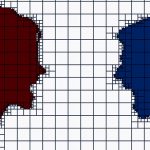France has sent three Dassault Rafale fighter jets to Poland to protect NATO’s eastern border following a series of Russian drone incursions, according to French President Emmanuel Macron.
A trio of French Air and Space Force Dassault Rafale omnirole fighter jets from the 2/4 Lafayette Squadron—each capable of carrying a nuclear weapon—were deployed to Poland last week following a string of Russian drone incursions into Polish airspace. The high-profile deployment comes as part of a broader NATO effort to bolster its eastern flank and deter Moscow from launching further incidents.
“I have decided to deploy three Rafale fighters to help protect Polish airspace and the Eastern Flank of Europe alongside our NATO allies,” French President Emmanuel Macron announced in a French- and Polish-language statement on X (formerly Twitter) on Thursday.
The Rafale Fighter Jets Are Nuclear-Capable
The 2/4 Lafayette Squadron, which can trace its origins back to the famed “Lafayette Esadrille” formed during World War I, and the Escadron de Chasse 1/4 Gascogne are the French Air and Space Force’s two nuclear strike squadrons. The aircraft are part of France’s nuclear triad, which also consists of ballistic missile submarines and land-based missiles.
Images of the three Rafale fighters’ arrival in Poland were shared on social media. Still, it appears highly unlikely that the jets were carrying nuclear weapons on their deployment. Instead, they will be expected to carry out conventional air superiority missions along NATO’s eastern flank, bordering Russia’s Kaliningrad exclave and Russian-allied Belarus.
As United24Media reported, the aircraft’s “presence in Poland carries symbolic weight, highlighting France’s role as a nuclear power within Europe.”
Following the recent cross-border incursions, Warsaw requested additional support to reinforce its air defense capabilities. Polish Deputy Prime Minister Wladyslaw Kosiniak-Kamysz reportedly spoke with Macron, who further had telephone calls with British Prime Minister Keir Starmer and NATO Secretary General Mark Rutte about the Russian drone deployments.
Last week, Rutte condemned the violation of Polish airspace.
“Allies are resolved to defend every inch of Allied territory. We will closely monitor the situation along our eastern flank, our air defenses continually at the ready,” Rutte told reporters at a press conference last week.
“The French and British are issuing their statements in the form of Rafale and Eurofighter aircraft to protect our skies,” added Kosiniak-Kamysz.
The Rafale Is in the World’s Crosshairs
The Dassault Rafale—literally meaning “gust of wind,” or “burst of fire” in a more military sense—was conceived for use by the French Air Force and Navy as an omnirole fighter, intended to replace seven different types of French combat aircraft in operation at the time of its development. The plane traces its origins back to the Avion de Combat Experimental (ACX) program in the early 1980s before France’s withdrawal from the multinational European Fighter Aircraft (EFA) project in 1985. It has been suggested that one reason Paris withdrew from the EFA was its requirement for a smaller and lighter combat aircraft that could operate from its aircraft carriers.
The ACX initially took the form of a technology demonstrator. It was first flown in July 1986 and was later redesignated as Rafale A. That initial aircraft established the primary design features for the Rafale, including its basic aerodynamic configuration, a fly-by-wire control system, and a structure that extensively utilized composite materials. In the years that followed, the Rafale was developed to carry out a wide range of missions, including air defense/air superiority, anti-access/area denial, reconnaissance, close air support, dynamic targeting, air-to-ground precision strike/interdiction, anti-ship attacks, nuclear deterrence, and even buddy-buddy refueling.
The aircraft has undergone steady upgrades since its introduction, making it a “4.5-generation” fighter in the modern understanding of the term. It is slated to remain the French military’s primary combat aircraft until at least 2050.
In March, Macron announced that Paris would seek to increase its fleet of Dassault Rafale omnirole fighters, while investing around €1.5 billion ($1.6 billion) to increase the capabilities of one of the French Air & Space Force’s bases.
The investment aims to expand the Luxeuil-Saint Sauveur Air Base, also known as Base Aérienne BA-116 or Air Base 1160, with two additional squadrons, each operating the Rafale. BA-116, located in eastern France, had previously been one of the facilities that housed the country’s nuclear deterrent aircraft. It lost that mission in 2011, but it will be resumed beginning in 2035.
As previously reported, Macron also floated the idea of having the French Air and Space Force and the Rafale take over the European nuclear deterrence role currently carried out by the United States, essentially expanding Paris’ nuclear umbrella.
During the Cold War, France had nuclear-capable F-100D/F Super Sabre jet fighters stationed at two bases in West Germany, and the Rafale could fill a similar role. But even if that does not happen, France will maintain the nuclear-capable aircraft from multiple domestic facilities.
About the Author: Peter Suciu
Peter Suciu has contributed over 3,200 published pieces to more than four dozen magazines and websites over a 30-year career in journalism. He regularly writes about military hardware, firearms history, cybersecurity, politics, and international affairs. Peter is also a contributing writer for Forbes and Clearance Jobs. He is based in Michigan. You can follow him on Twitter: @PeterSuciu. You can email the author: [email protected].
Image: Shutterstock / Flavien Dessertine.

















